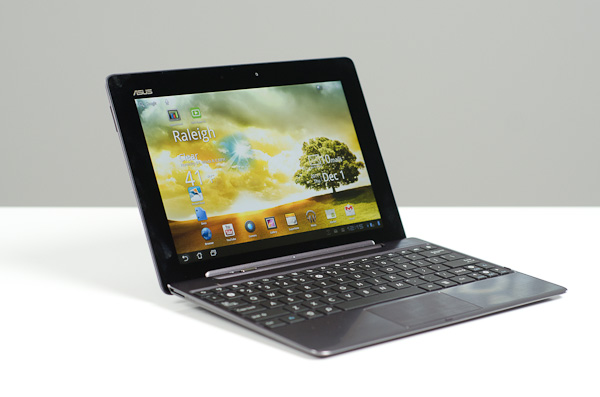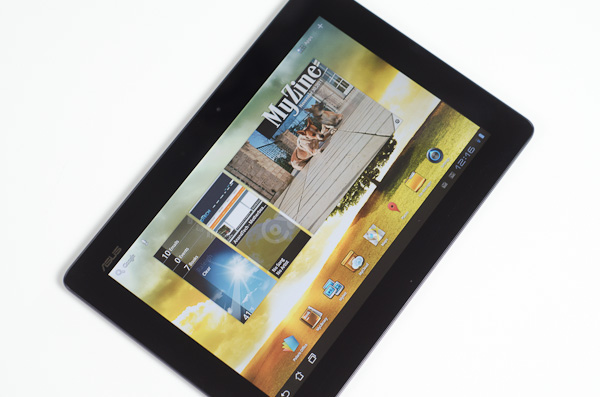ASUS Eee Pad Transformer Prime & NVIDIA Tegra 3 Review
by Anand Lal Shimpi on December 1, 2011 1:00 AM ESTFinal Words
Assuming the WiFi and minor dock issue I encountered aren't widespread (ASUS insists they aren't), I am comfortable calling the Eee Pad Transformer Prime the absolute best Android tablet on the market today. The hardware looks and feels great. ASUS picked the best display possible and married it to some really good industrial design. I was impressed with the styling of the Zenbook, and the Prime continues to position ASUS as a purveyor of high quality mobile devices.
At the same time, NVIDIA has finally delivered an SoC capable of delivering the sort of smooth experience we'd expect from a $500 tablet. Honeycomb was a great first attempt by Google at a tablet OS, but Tegra 3 really makes the whole experience complete. Everything you'd expect to be smooth, is finally smooth. Video playback is no longer an issue, the Prime and Tegra 3 can finally play back virtually anything you'd want to throw at it. Thank goodness.
As good as the combination is today, I admit that I still can't wait to put Ice Cream Sandwich on this thing. Even more polish on the OS side (and the absence of any hardware issues during the testing process) would've easily catapulted the Prime into editor's choice territory.
Battery life is the big unknown at this point. At worst it's roughly on par with the old Eee Pad Transformer. I'll know more in the coming days, but 9 hours of continuous use isn't bad. The question is how much better will it be as we start playing with the available power options? I'm also curious to see what having four cores does to web page loading performance. There's clearly an impact on JavaScript rendering, but what about the overall real world experience? In my testing I was limited by the WiFi issue I mentioned earlier, but I hope to have an answer to this soon enough.
The inevitable iPad comparison is, well, inevitable. I still firmly believe there's not a whole lot of iOS/Android cross shopping. If you want an iPad, that's what you should buy. Android isn't an iOS substitute, just as iOS isn't an Android substitute. You can do similar things on both, but personal preference will really determine what suits you the best.
I'll have more coverage on the Prime over the coming days, but if you're making your decision before then: this is the Android tablet to get.
Update: ASUS has removed GPS support from the Prime's official spec sheet. Check out our update here as well as our follow-up to the review.












204 Comments
View All Comments
ATOmega - Tuesday, December 6, 2011 - link
Exactly my reasoning, and it's easy enough to see that the Transformer Prime boasts better features like GPS, camera and display.After having owned an iPad2, there must be a reason why I want this thing. And it's for all the things Apple decided to fleece me on so that they could jack up their margins.
I never liked Apple in the first place, but it's obvious they don't want to truly compete with the Android OS.
sigmatau - Thursday, December 1, 2011 - link
I was really hoping Nvidia would have something special with kal-el. This is pretty horrible when compared to hardware that has been available for about a year.It seems that the Nvidia-equiped tablets should be targeted at a much lower price point. They definetly should not be in the top tier tablets. I can see them selling at $300 or less.
UpSpin - Thursday, December 1, 2011 - link
Don't forget the display brightness. I don't think that the processor makes such a huge difference in power consumption, but the display on the Prime is much much brighter than the display of the iPad, and this will consume a huge amount of power. It's also brighter than the display of the first gen transformer, and the prime has a quad core and it gets the same or higher battery life than the first gen, I think that's really a big improvement.And if you want to use a tablet on the go, outside the house, you really need the brightest display possible. And as you can see in the picture, the difference between the sunlight visibility of the iPad and Prime is like day and night. Therefore I at least, sacrifice the 3 hours less battery life.
name99 - Thursday, December 1, 2011 - link
The display surely only uses more power if you drive it at a brighter level?And a well-designed tablet should have a light sensor, and should do a good job of auto-calibrating the brightness to the environment, so that most of the time it is NOT running the screen in bright mode. After all, that's what we expect regarding the core --- we throttle CPU when it's not needed. So, sorry, I don't think this is an acceptable answer.
I continue to state my original thesis --- I suspect that DRAM power is substantially more important than most people believe, and that one of Apple's advantages is that they ship iOS devices with minimal DRAM. This is obviously a hassle for developers, and even for some power users, but that's the tradeoff one has to make.
(Also what's the story with Android and VM? iOS does NOT do any "write" swapping --- code is paged in, but data is not paged out, and I expect that this is a power issue, nothing else --- Apple doesn't want the power hit of swapping.
I thought Android was like this --- did not write pages --- but I have read stuff recently that said no, it is now using standard desktop type VM, which is likely also a power sink.)
metafor - Thursday, December 1, 2011 - link
nVidia's solution is actually much more sophisticated than that. It's similar to a method Intel started using a ways back for laptops.It's not just auto-dimming the entire screen; it's auto-dimming every pixel individually. There is fine-grain control over the LED backlight of the display. Areas in each frame that contains black will now not only have the LCD crystal for that pixel in a "block" mode, but it will also have the backlight for that specific pixel dim.
This actually produces benefits other than just battery life; one of the biggest problems with LCD's is that blacks aren't really black because the crystal isn't able to block 100% of the backlight.
By dimming the backlight, the parts of an image that is supposed to be black will be closer to true black. This improves contrast and provides for more accurate pictures.
UpSpin - Friday, December 2, 2011 - link
how shall this work if the backlight is created by an LED array at the edge, which almost all smaller (<20") displays are. So with an edge lit backlight you can't reduce the LED brightness block wise.This is different if the used panel has a full array of LEDs, which is expensive, more power consuming and thicker, so a no go on a mobile device that thin. And neither Intel nor Nvidia have impact on this, because this requires a different panel.
TechAnandUser - Friday, December 2, 2011 - link
BenchMarking App's are not yet optimized. So please wait !!fteoath64 - Friday, December 2, 2011 - link
Why would you want a Win8 tablet ?. Its slow, heavy, short battery-life and probably cost 50% more!.You are better off with a mid-range slim laptop which you probably have. So unless you grab one of these or already have an ipad, you have no idea what a tablet can do for you.eddman - Friday, December 2, 2011 - link
You might have a time machine then, cause right now there are no win 8 tablets, let alone ARM based ones.tipoo - Thursday, December 15, 2011 - link
"Its slow, heavy, short battery-life and probably cost 50% more"Citation needed, citation needed, citation needed, and citation needed respectively. None of us have tested finalized W8 table hardware yet, unless you are from the future.